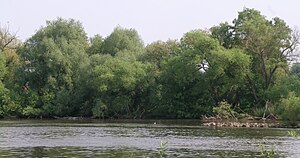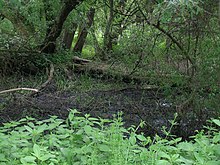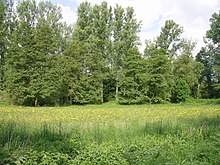Main meadows near Sulzbach and Kleinwallstadt
|
Main meadows near Sulzbach and Kleinwallstadt
|
||
|
Main meadows (view from the other bank of the Main) |
||
| location | Sulzbach am Main / Kleinwallstadt , Miltenberg district , Bavaria | |
| surface | 89.21 ha | |
| Identifier | NSG-00476.01 | |
| WDPA ID | 164553 | |
| Geographical location | 49 ° 54 ' N , 9 ° 9' E | |
|
|
||
| Sea level | from 114 m to 122 m | |
| Setup date | June 10, 1994 | |
The Mainauen nature reserve near Sulzbach and Kleinwallstadt is located in the Miltenberg district and includes the natural river landscape on the right bank of the Main between the Lower Franconian communities of Kleinwallstadt and Sulzbach am Main . It is the last near-natural meadow area on the Untermain.
Change of the bank areas through river corrections
Until the beginning of the 19th century, the banks of the Main were unpaved and often swampy . The river had only a shallow water depth, which also changed significantly with the seasons. Riverside areas were regularly flooded . The navigation took place in small boats upstream by towing , downstream by sailing or drifting.
Due to the increasing demands of shipping, in the middle of the 19th century there was a mean water correction with the aim of a minimum fairway depth of 90 cm and a fairway width of 26 m. In the river looking groynes the narrowed river bed and raised the water level, but also the flow rate in the middle of the river. As a result, sediments were removed from the bottom of the river bed, while sediment deposits were simultaneously deposited in the area of the groyne fields at a slow flow rate. The towpaths required for towing on the bank were paved. Since the ships were pulled by horses on long ropes, there was no higher vegetation between the bank and the towpath. From an ecological point of view, the mean water correction already meant the first significant changes in the bank landscape.
With the introduction of steam shipping , the ever larger ships were towed as a towing formation by chain tugs from the end of the 19th century and the towing ship was abandoned. The chain shipping Although increased transport capacity on the Main significantly, but demand grew of cheap and fast transportation routes through the increasing industrialization faster. This could only be achieved through an even greater depth of the fairway and, at the same time, a lower flow velocity. From 1920 the Main was rebuilt into a large shipping route by damming the river into lake-like, slowly flowing sections . Shallow water areas, oxbow lakes and groyne fields were cut off and aufgelandet mostly in favor of other use and filled. The banks were paved with piles of larger stones. These measures represented a massive intervention in the landscape in most of the river sections. Near-natural river floodplains were only preserved in a few places.
History, location and size of the nature reserve
The preservation of the near-natural river landscape between Sulzbach and Kleinwallstadt is due on the one hand to the separation of the Main foreland by the railway line ( Maintalbahn ) completed in 1876 from the closed local area of Sulzbach. On the other hand, regular floods prevented settlement. The area was used extensively . On May 16, 1994, the 50 m to 400 m wide and about 5 km long bank and foreland strip was designated as a nature reserve by the Lower Franconia government .
The "Mainauen bei Sulzbach and Kleinwallstadt" nature reserve is located on the right-hand side of the Main in the lower and middle reservoirs between the barrages of Obernau and Kleinwallstadt . The largest part of the nature reserve is located on the district of the market Sulzbach. The southern part belongs to Kleinwallstadt, while a small part in the north is part of the Niedernberger area. The nature reserve is flanked in the east by the state road St2309, which runs directly along the nature reserve. It is cut in two by the state road St2313 leading to the Main Bridge and the access road to the Natorampe .
In 2004, the nature reserve was incorporated into the newly designated FFH area (Flora-Fauna-Habitat) “ Main valley and slopes between Sulzbach and Kleinwallstadt ”, which has a total size of around 300 hectares.
Flora and fauna
The reserve "floodplains in Sulzbach and Kleinwallstadt" consists of different widths, Auwald similar bank of woody plants and upstream groyne fields as well as the underlying grassland and orchards . Different zones are distinguished within the protected area. Entry into the zones of type "A" and "B" is prohibited.
A particularly protected area is the 550 m long and up to 70 m wide strip of "Kleiner Gries" near Kleinwallstadt. The strip is shaped by an approximately 70 m long old arm , which has a one-sided connection to the main stream via the upstream groyne field . The area around the oxbow lake is characterized by dense vegetation of willow trees, tall perennials , reed , nettle and herb fringes and is surrounded on the land side by extensively used grassland. Floating leaf plants such as the pond rose , but also irises and other moisture-loving plant species can be found in shallow water areas with little current . The diversity of vegetation offers many species of birds, some of which are threatened, with a quiet zone, food, breeding and habitat. The Kleine Gries belongs to zone "A" and thus one of the two most valuable and sensitive sub-areas of the protected area.
In the north of the protected area is the "Kohlplatz", an area of floodplain that is characterized by high soil moisture . It is caused by the damming of the Main, but also by the Sulzbach that flows through this area. The original course of the stream was relocated when the river was regulated and, compared to the original mouth, flows into the Main about 150 m downstream. Larger areas of the alder forest are swampy areas and provide an optimal habitat for swamp plants , amphibians , dragonflies and numerous songbirds . But the beaver has also settled here. In spring, large parts of the Kohlplatz are covered with a thick carpet of wild garlic .
The grassland areas that make up a large part of the nature reserve are extensively used lean flatland hay meadows . It is mowed only a few times a year, but not before the main flowering time of the meadow flowers. This leads to flower-rich grassland areas, which lead to a particularly rich variety of insects such as butterflies and wild bees . There is no artificial fertilization of the meadows. The grassland areas are also breeding and resting places for many birds such as geese.
In the Mainauen nature reserve there are numerous reed beds along the banks of the Main and the flood ditch. These areas offer ideal living conditions for numerous insects and bird species. The large reed areas at the time of designation as a nature reserve in 1994 have, however, been reduced to around half. This is due on the one hand to the changes in the bank reinforcement to protect against the impact of waves, but on the other hand to a too small protective strip around the reed areas when mowing. These changes have certainly also led to the fact that the Marsh Harrier , which at that time was still breeding regularly in the reeds, has not been present for several years and the number of great crested grebes has also decreased significantly.
On the other hand, new bird species can be found in the Main meadows. Since 1989 various species of geese have been observed, such as the gray goose , the Egyptian goose and the Canada goose , which find their breeding grounds here.
Probable female of the purple gold fire butterfly on a field scabious
Lichen on tree bark
Blue feather dragonflies during mating
Landing of an Egyptian goose on the Main
Sunset over the Main meadows
See also
Web links
- NSG Mainauen near Sulzbach and Kleinwallstadt. Bund Naturschutz in Bayern eV - Miltenberg district group, accessed on December 24, 2019 (German). Video “Walk through the Mainaue”and two brochures for download.
Individual evidence
- ↑ Main meadows near Sulzbach and Kleinwallstadt. In: protected planet. Retrieved December 24, 2019 .
- ↑ a b c d e f g h i j Bund Naturschutz in Bayern e. V., district group Miltenberg, state association for bird protection in Bavaria e. V. and hiking club "Spessartfreunde" Sulzbach e. V., (Ed.): The Main meadows near Sulzbach and Kleinwallstadt . For 25 years nature reserve :. Obernburg June 2019 ( naturtalent-gesucht.de [PDF]).
- ↑ a b c Wanderverein Spessartfreunde Sulzbach (ed.): The Sulzbacher Mainaue . The attempt at an ecological landscape representation. 1989, The history of the Main and other things worth knowing, p. 62–71 ( naturtalent-gesucht.de [PDF; accessed on January 2, 2020]).
- ^ Government of Lower Franconia (ed.): Official Journal of the Government of Lower Franconia . Ordinance of the government of Lower Franconia of May 16, 1994 No. 820-8622.01-10 / 89 on the nature reserve "Mainauen bei Sulzbach and Kleinwallstadt". 39th year, no. 8 . Würzburg May 16, 1994, p. 95–110 ( landkreis-miltenberg.de [PDF; accessed on January 2, 2020]).
- ^ Main valley and slopes between Sulzbach and Kleinwallstadt. In: protected planet. Retrieved December 25, 2019 .









